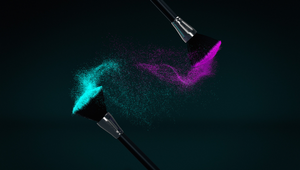
The Science of Creativity: How Saddington Baynes Is Pioneering Neurocreative Production

At London-based production studio Saddington Baynes, innovation has always been key to the company’s success. With a legacy built on 30 years of working with some of the world’s top brands, from Acura to Jo Malone London, to the likes of Gaggenau and Graff Diamonds - The Cannes Lions winning studio’s approach to creativity and science is unique, and today the team explains how this approach has been formed to put emotion-led creativity first.
With the advent of Engagement Insights® - the company’s award-winning consultation service which ‘tests implicit associations to measure emotional pull and attribute resonance’ - in 2014, a new era for the longstanding studio emerged. Working with brands to tap into the psychology behind campaigns and to see what resonates with audiences, Saddington Baynes is one of the first production studios to move in this forward-thinking direction.
Meanwhile, at 30 the studio has seen a lot of change both internally and with new moves in the world of post; more recently, companies have been pushing against the notion that ‘post-production’ comes last. Saddington Baynes is one of the companies taking CGI, VFX, and retouching upstream in order to achieve better results for agency and brand clients.
For a company that has always put a strong emphasis on the ‘visionary,’ LBB was keen to learn what this represents: “Multiple times, we’ve been at the forefront of change: we trailblazed the move from analogue to digital retouching in the 90s, proved the need for CGI in automotive advertising in the mid-noughties, and more recently incorporated neuroscience to optimise the impact of the creative work we do,” says James Digby-Jones, co-owner and ECD.
Here, the team at Saddington Baynes reveal to LBB what motivated their neuro-led move, why their full CGI approach is captivating brands, and how the studio is continuing to innovate.
A neuro-led approach to production
Perhaps the real turning point for luxury-focused studio Saddington Baynes was the launch of its Neuroscience consultancy service Engagement Insights in 2014, which the team tells LBB came out of a need ‘to gauge what effect and impact post-production has on campaign and brand perception.’ The resounding answer they found is that ‘yes, it does’.
“Once we discovered that it does have an impact and how imperceptible changes can have a profound effect on responses, we set about developing a service that allows us to measure - at key critical junctions - the emotional impact and brand resonance of the work we do for our clients,” says James.
Since then, the last seven years have seen Saddington Baynes create highly effective campaigns for the likes of Honda, Estée Lauder, and jewellery and watch designers Marie Boutteçon and Etienne Ruffieux.
“Testing specifically on emotions gives us a brand new, consumer-centric perspective to how brands are creating content,” says Callum Gould, head of insights. “The only way we can achieve this level of insight and be able to stand confidently and say some relatively controversial opinions - for example that talent and influencer marketing is not as effective as brands think - is by looking holistically at different sectors and reviewing large numbers of creative at once.
James adds that the Saddington Baynes approach helps the team know ‘which levers to pull to take the imagery in the most relevant direction to express the creative in the most potent way, to both optimise the creative and hone the visual language to the intended audience.’
It has also allowed the team to streamline its decision-making, and understand creative trends at an emotional level. That’s afforded the team added confidence in its own creative direction, adds Chris Christodoulou, CEO and co-owner, who as the company’s first full-time employee back in 1994 has been at the centre of Saddington Baynes’ evolution.
So, how did the pivot to science happen?
“Everything we do as image-makers is about crafting the most emotional reaction with our work to increase the perception of the campaign and the brand we’re working with,” says Chris. “Rather than trying to test emotions by asking questions of the consumer in a survey or focus group, which changes the response, we wanted to know before and during production, not after, whether our work is resonating the way we and the client intended.”
And it all comes back to the key components that impact emotional responses: desire and trust. “We aim to craft the most sensational imagery in the world, and Engagement Insights gives us the platform to actually achieve this,” says Ellie Lucas, commercial director. The work of studios like Saddington Baynes to go neuro-led perhaps helped set the context for Orlando Wood’s 2019 book, Lemon, which put forward theories suggesting that technology itself is not a guarantee of advertising success, but that it’s the creative application of technology that really counts.
The team’s work with Honda is a standout example of where Engagement Insights can help brands reach their potential. The project saw Saddington Baynes create online films for Honda’s Real View Test Drive campaign in 2018: “Engagement Insights was able to uncover consumer responses using neuroscience techniques to identify and optimise key points of visual impact. We fused together live video, CGI, and motion graphics, smoothly turning a large-scale integrated production into a streamlined campaign launch. Altogether, we delivered almost 60 minutes of content for the 20 digital films: over 300 shots and 900 outputs for four different vehicles!” says James.
“As a result, website visitors spent six times - 13 and a half minutes - longer on-site, were twice as likely to enter the Honda Car Configurator process, and were twice as likely to enter Honda’s Book a Test Drive process,” he adds.
The team at Saddington Baynes added to its engagement offering in 2020 with the creation of its Perception Index, which built on its Engagement Insights tool to conduct an industry-wide study. Taken from campaigns across automotive, beverage, cosmetic, fragrance and watch sectors, the neuromarketing team found out, for example, how The Body Shop in the beauty market came out on top for trust, and in the automotive market, the team found Honda came out on top for efficiency and found that ‘Auto imagery was also considered the least distinctive and their product imagery, which sits on their 'points of purchase' web pages, have significantly weak associations with premium quality and progression.’
Meeting the needs of a multi-channel marketing landscape
“The film world turned to full CG many years ago for a reason, to tell stories in new ways,” says Chris.” That’s where CGI really meets the needs of today’s multi-channel marketing landscape: Designing full CGI environments means they become valuable, reusable brand assets that are ‘always-on’, deliver visual consistency across channels, and allow creatives to design their campaign imagery much earlier.”
With Ferrari, Saddington Baynes created a fully CGI environment, from vehicle to passerby, for the brand’s ‘488 Spider’ campaign. The project won bronze in the 3D category at the Creativepool Annual Awards in 2021 and highlights the power of full CGI creative. And as the number of media channels continues to grow exponentially, insights have become crucial benchmarks for brands who are traversing so many different consumer touchpoints.

A cross-industry approach to creativity
Saddington Baynes' 30-year long history has allowed it to observe industry changes, especially pertinent now as channels merge and identify sectors that need more insight and science behind creative production.
“As creatives working across all industries, it’s fascinating to see how different sectors approach their marketing,” says Ellie. One industry, in particular, has come under fire in recent years, and that’s beauty.
“We’ve watched the beauty industry face continuous criticism around ethical and social responsibility. From animal testing to impossible beauty standards, the beauty industry is losing authenticity and audience trust,” she adds. Earlier this year, research from market research company Mintel found that 73% of adults agree the beauty industry plays on women’s insecurities. Saddington Baynes’ work is aiming to move in a different direction.
SBLabs - Saddington Baynes’ internal lab - came up with its own take on beauty advertising; “Redefining Beauty’ makes use of CGI and VFX to show what the beauty industry can achieve when taking the onus away from celebrity figures and unachievable beauty expectations.
“So with this shift of focus for brands to become advocates of change and a growing popularity in campaigns promoting body positivity and female empowerment; we wanted to show how brands can implement positive change, that not only boosts brand awareness, trust, and authenticity but actually generates more desire and product value,” says Ellie.
As Saddington Baynes looks to the next 30 years, the studio is reflecting on its first 30; So how will its learnings continue to mould its future?
“Across the last 30 years, our main focus has remained the same: to create sensational, beautiful, and believable imagery. Working in CGI allows us to be the architects of the final mood, using lensing and the language of photography and lighting,” says James. “I think the best way to summarise our first 30 years in business is to say it has been a voyage of exploration, discovery, and innovation, and as we move forward, keeping these core principles while bringing whatever innovations come next into the fold.”













